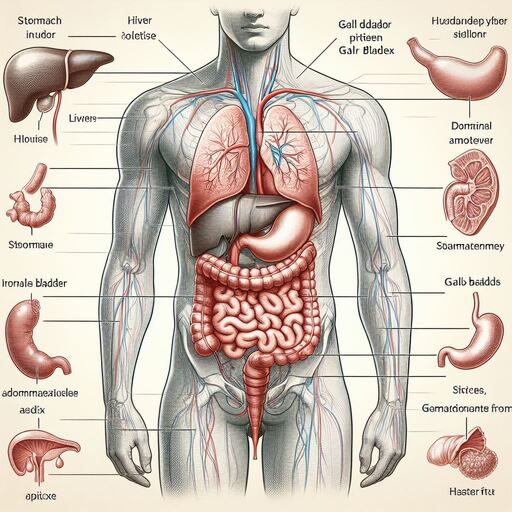Understanding Abdominal Pain
Understanding Abdominal Pain
Abdominal pain is a common and often disruptive symptom that can arise from a variety of underlying causes. It’s crucial to understand the potential reasons behind abdominal pain and how to effectively manage and alleviate it to restore wellness and comfort. In this comprehensive guide, we’ll delve into the different types of abdominal pain, their possible causes, when to seek medical attention, and strategies for finding relief and promoting overall well-being.
Types and Causes of Abdominal Pain
Understanding Abdominal Pain
Abdominal pain can manifest in diverse ways, ranging from dull aches to sharp, intense cramps. The location and nature of the pain can provide valuable clues about its potential origin. For instance:
- Upper Abdominal Pain: Pain in the upper abdomen could be linked to conditions affecting the stomach, pancreas, gallbladder, or liver. Gastritis, peptic ulcers, gallstones, or pancreatitis are common causes.
- Lower Abdominal Pain: Pain in the lower abdomen may stem from issues with the intestines, urinary tract, reproductive organs, or pelvic region. Causes could include irritable bowel syndrome (IBS), constipation, urinary tract infections, or gynecological conditions like endometriosis.
- Localized Pain: Pain that is specific to one area of the abdomen might indicate a problem with a particular organ or structure in that region. For example, appendicitis typically causes sharp, localized pain in the lower right abdomen.
- Generalized Pain: If the pain is diffuse and spread across the entire abdomen, it could be a sign of a more widespread issue like food poisoning, viral gastroenteritis, or a systemic infection.
When to Seek Medical Attention
While occasional mild abdominal discomfort is usually not cause for concern, certain symptoms accompanying abdominal pain warrant prompt medical evaluation. Seek medical attention if you experience:
- Severe or persistent pain that doesn’t improve with over-the-counter medications.
- Pain accompanied by fever, vomiting, diarrhea, or blood in the stool.
- Pain that worsens with movement or certain activities.
- Abdominal pain during pregnancy.
- Pain after recent abdominal surgery or trauma.
Ignoring severe or unusual abdominal pain can lead to serious complications if there’s an underlying medical condition that requires treatment.
Diagnostic Approaches
Diagnosing the cause of abdominal pain often involves a combination of medical history assessment, physical examination, and diagnostic tests. Your healthcare provider may:
- Ask detailed questions about your symptoms, eating habits, and medical history.
- Perform a physical examination to check for signs of inflammation, tenderness, or abnormal masses.
- Order tests such as blood work, imaging studies (like ultrasound or CT scan), or endoscopic procedures (such as colonoscopy) to visualize internal structures.
These diagnostic tools help identify the underlying cause of the abdominal pain and guide appropriate treatment.
Understanding Abdominal Pain
Strategies for Finding Relief and Wellness
Once the cause of abdominal pain is identified, the next step is to alleviate discomfort and promote overall wellness. Treatment strategies vary depending on the underlying condition but may include:
- Medications: Prescription or over-the-counter medications can help manage pain, reduce inflammation, or treat infections contributing to abdominal discomfort.
- Lifestyle Modifications: Adopting healthy lifestyle habits can significantly improve digestive health and reduce abdominal pain. This includes eating a balanced diet rich in fiber, staying hydrated, and avoiding trigger foods that exacerbate symptoms.
- Stress Reduction: Stress can worsen abdominal pain in conditions like IBS. Incorporating relaxation techniques such as meditation, yoga, or deep breathing exercises can be beneficial.
- Physical Activity: Regular exercise promotes healthy digestion and can alleviate abdominal discomfort. Aim for moderate physical activity such as walking, swimming, or cycling.
- Alternative Therapies: Some individuals find relief from abdominal pain through complementary therapies like acupuncture, herbal remedies, or probiotic supplements. However, consult with a healthcare provider before trying alternative treatments.
Conclusion
Understanding abdominal pain is essential for effectively managing symptoms and improving overall well-being. By identifying the type and potential causes of abdominal pain, seeking timely medical attention when necessary, and adopting appropriate lifestyle modifications and treatments, individuals can find relief and regain control over their digestive health. Remember, every individual is unique, so it’s important to work closely with healthcare professionals to develop a personalized approach to managing abdominal pain and promoting long-term wellness.
Understanding Abdominal Pain
